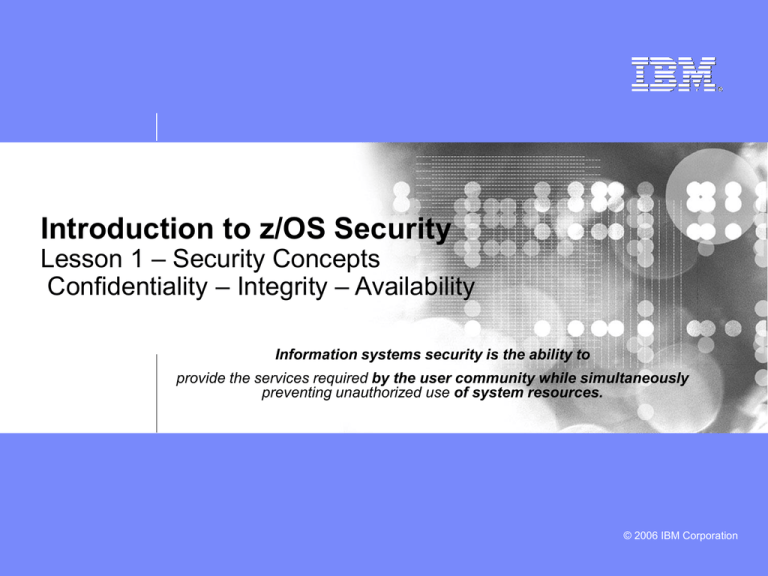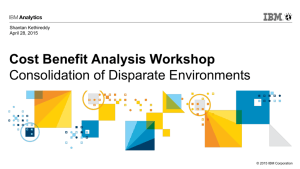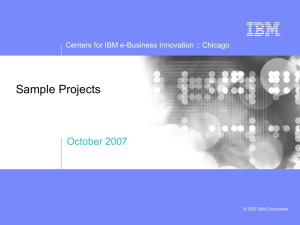Introduction to z/OS Security
advertisement

Introduction to z/OS Security Lesson 1 – Security Concepts Confidentiality – Integrity – Availability Information systems security is the ability to provide the services required by the user community while simultaneously preventing unauthorized use of system resources. © 2006 IBM Corporation Objectives –At the completion of this topic the student should understand: •Why security is vital for computing systems •The basic concepts of information system security •How these basic concepts are implemented 2 © 2006 IBM Corporation Key terms 3 Security Authentication Confidentiality Identity Integrity Authorization Authenticity Access Accountability Access Control Lists (ACLs) Non-repudiation Intrusion Detection Availability Denial of Service © 2006 IBM Corporation Introduction Security is a compromise between opening the systems up to the world and locking them down so no one can use them. Neither scheme is secure because they break one of the basic tenets of Security. Opening up the system devalues Confidentiality, while locking the system down prevents Availability. Key to the understanding of information security is the CIA model – Confidentiality, Integrity, and Availability 4 © 2006 IBM Corporation Security Information systems security is the ability to provide the services required by the user community while simultaneously preventing unauthorized use of system resources. Providing the system resources to those who need them is just as much a part of system security as protection and prevention of undesired use of those resources. 5 © 2006 IBM Corporation Confidentiality The concept of Confidentiality in information security pertains to the protection of information and prevention of unauthorized access or disclosure. The ability to keep data confidential, or secret, is critical to staying competitive in today’s business environments Loss of confidentiality jeopardizes system and corporate integrity. 6 © 2006 IBM Corporation Threats to confidentiality –Hackers • A hacker is an individual who is skilled at bypassing controls and accessing data or information that he or she has not been given authorization to do so. –Masqueraders • Authorized users on the system that have obtained another persons credentials. –Unauthorized Users • Users that gain access to the system even if “company rules” forbid it. –Unprotected Downloads • Downloads of files from secure environments to non-secure environments or media. –Malware • Virus and worms and other malicious software –Software hooks (Trapdoors) • During the development phase software developers create “hooks” that allow them to bypass authentication processes and access the internal workings of the program. When the product development phase is over developers do not always remember the hooks and may leave them in place to be exploited by hackers. 7 © 2006 IBM Corporation Integrity Integrity deals with prevention of unauthorized modification of intentional or accidental modification. This concept further breaks down into authenticity, accountability, and non-repudiation. –Authenticity means that the information is from whomever we expect it to be and whatever we expect it to be. –Accountability means that the information has an owner or custodian who will stand by its contents. –Non-repudiation is a property achieved through cryptographic methods which prevents an individual or entity from denying having performed a particular action related to data 8 © 2006 IBM Corporation Availability Availability assures that the resources that need to be accessed are accessible to authorized parties in the ways they are needed. Availability is a natural result of the other two concepts. If the confidentiality and integrity of the systems are assured their availability for the purpose they are intended for is a direct consequence. Threats to Availability –Availability can be affected by a number of events which break down into human and non human influenced factors. These further break down to unintentional and intentional acts. –Examples of unintentional (non-directed) acts can be overwriting, in part or whole, of data, compromising of systems, or network infrastructure by organizational staff. –Intentional acts can be conventional warfare (bombs and air-strikes), information warfare denial of service (DoS) and distributed denial of service (DDoS). –Non-human factors include loss of availability due to fires, floods, earthquakes and storms. 9 © 2006 IBM Corporation Authentication Authentication is the process by which the information system assures that you are who you say you are; how you prove your identity is authentic. Methods of performing authentication are: –user ID and passwords. The system compares the given password with a stored password. If the two passwords match then the user is authentic. –Swipe card, which has a magnetic strip embedded, which would already contain your details, so that no physical data entry takes place or just a PIN is entered. –digital certificate, an encrypted piece of data which contains information about its owner, creator, generation and expiration dates, and other data to uniquely identify a user. –key fob, small electronic devices which generate a new random password synchronized to the main computer –Biometrics - retinal scanners and fingerprint readers. Parts of the body are considered unique enough to allow authentication to computer systems based one their properties. For a very secure environment, it is also possible to combine several of these options, such as by having fingerprint identification along with user ID and key fob. 10 © 2006 IBM Corporation Non-repudiation Data flows around the internet at the speed of light, or as close to it as the servers allow. There are hackers, spoofers, sniffers, and worse out there just waiting to steal, alter, and corrupt your information. Data consumers need to be able to trust that the data has not been altered, and that its source is authentic. Through the use of security related mechanisms, producers and consumers of data can be assured that the data remains trustworthy across untrusted networks such as the internet, and even internal intranets. 11 © 2006 IBM Corporation Assuring data validity The identity of the data producer can be assured if the data is signed by its source. Data is signed through its encryption using a shared secret such as a numerical crypto key or using a “public/private” key pair The consumer of the data can validate the signature of the data and thereby be assured that the data has remained unaltered in transmission. Since the data could be decrypted into something intelligible, the content is valid. 12 © 2006 IBM Corporation Authorization Authorization is the granting or denial of resource access to a user. It is dependent on the access rights to a resource existing on the system. Identification and authorization work together to implement the concepts of Confidentiality, Integrity, and Availability. –Confidentiality - A user’s identity is authenticated by the system. That user is subsequently represented in the system by a token - either character or numerical data. By using this token, access to data and resources can be allowed or denied. –Integrity - Authorization provides the mechanism to prevent the disruption of data by known users with out the appropriate authority. –Availability - the ability to touch resources that you are permitted to touch, is backed by the ability to authorize users to resources. 13 © 2006 IBM Corporation Identity Simply put, identity is how you are known to the information system. A character based user ID represents an identity on z/OS and other systems. –TSO supports a 7 character user ID even though RACF provides for 8 On Unix® systems a numerical UID is used to represent the identity of a user. A user presents his identity as part of the credentials used to authenticate that user to the system. Without this authentication, authorization is impossible. "UNIX is a registered trademark of The Open Group" 14 © 2006 IBM Corporation Access Access is defined as: A means of approaching, entering, exiting, communicating with, or making use of In information security, access is requested by a resource manager on behalf of a user’s request to make use of a resource. Access is controlled – either granted or denied – partly through the use of Access Control Lists (ACLs). –ACLs contain the user’s identity and the highest allowed level of use. Levels of use or Access Levels can be one of: –None No access is granted to the specified resource –Execute Execute access allows users and groups to execute programs from the library, but they cannot read or write to the library. –Read Read access is the lowest level of permission to a resource. This allows users and groups to access the resource but not to alter its contents –Update Update access allows users and groups to change the contents of resource. The user is not authorized to delete the resource. –Control Control access grants users and groups authority to VSAM datasets that equivalent to the VSAM control password. –Alter Alter access allows users and groups full control over the resource. 15 © 2006 IBM Corporation Denial of Service A "denial-of-service" attack is an attempt by attackers to prevent legitimate users of a service from using that service. Examples include –Flooding the network to overwhelm the daemons and servers –Disrupting connections between systems –attempts to prevent a particular individual from accessing a service Not all service outages, even those that result from malicious activity, are necessarily denial-of-service attacks. Other types of attack may include a denial of service as a component, but the denial of service may be part of a larger attack. Unauthorized use of system resources may result in denial of service. –For example, an intruder may use your anonymous ftp area as a place to store large amounts of data. This would consume space and perhaps prevent the server from performing its intended duties. 16 © 2006 IBM Corporation Intrusion Detection It is becoming increasingly important to detect patterns of usage that might indicate impending attacks. Many attacks follow a sequence of information gathering, unauthorized access to resources, and denial of service. It can be difficult to determine the originator of denial of service attacks. Correlating information gathering activities with access violation may help identify an intruder before they succeed. Intrusion Detection Services (IDS – a part of CS390) provides support for: –Scan detection and reporting •Scans are recognized as the result of multiple information gathering events from a single source IP within a defined period of time. –Attack detection, reporting and prevention •An attack can be a single packet designed to crash or hang a system. An attack can also consist of multiple packets designed to consume a limited resource causing a network, system or application to be unavailable to its intended users (that is, denial of service). 17 © 2006 IBM Corporation Summary Computer systems security is the ability to provide the services required by the user community while simultaneously preventing unauthorized use of system resources. Information Security revolves around the implementation of the CIA Model of Confidentiality, Integrity, and Availability User’s identities are authenticated in order to determine authorization to resources. Access is granted to identities based on ACLs. A Denial of Service attack is a threat to security because it prevents users from accessing resources. Intrusion Detection should be implemented in order to sense an attack before or as it occurs. 18 © 2006 IBM Corporation




